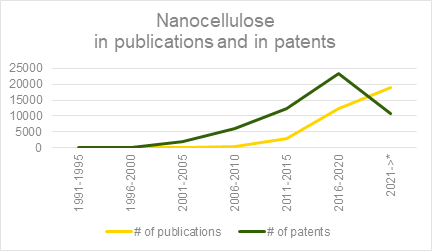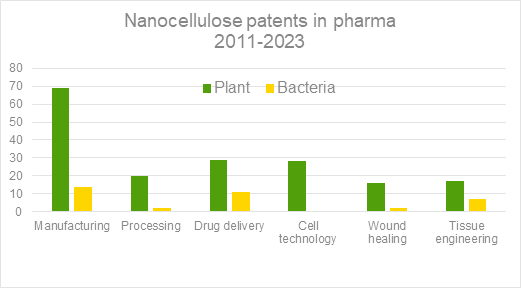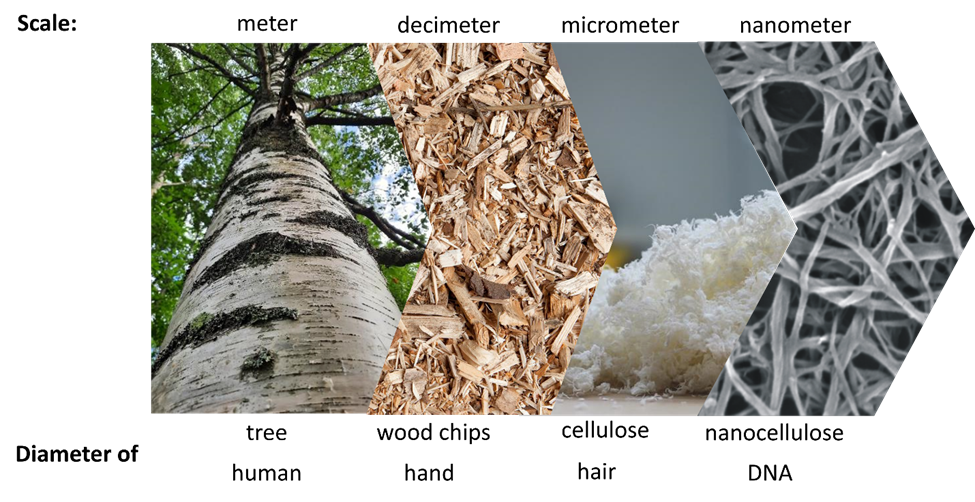Innovation at UPM: Transforming Nanocellulose for Medical Applications
This is the story of UPM’s nanocellulose hydrogel. UPM Biomedicals has been at the forefront of nanocellulose innovation, transforming it from a high-volume commodity to a high-value specialty material for the pharmaceutical and medical technology industries. The company’s pioneering efforts have opened new avenues for nanocellulose in medical applications, underscoring UPM’s commitment to innovation and sustainability.
Nanocellulose Research: A Global Perspective and Pharmaceutical Potential
Nanocellulose has been a subject of research across the world for decades. This is evident from the growing number of publications and patents in this field. Researchers are eager to publish their findings to further their careers, while industries actively file patents to protect innovations. Globally, there are more than 50,000 nanocellulose-related patents.

Figure 1: Search results from Google Scholar and Google Patents using terms related to nanocellulose.
In a 2024 review, Garcia et al. studied patents from 2011 to 2023 related to nanocellulose in the pharmaceutical field. Of the 1,952 patents identified, 215 focused specifically on pharmaceutical applications. These were categorized into areas such as manufacturing, drug delivery, cell cultivation, wound healing, and tissue engineering.
Plant-Based Nanocellulose: Leading the Way in Pharmaceutical Innovations
Nanocellulose can be derived from various sources, including plants and bacteria. The review by Garcia et al. revealed that plant-based nanocellulose dominates pharmaceutical applications, with 179 patents compared to only 36 for bacterial nanocellulose. When looking at the results from cell technology, it suggests greater suitability of plant-based nanocellulose for such applications. This in turn means limited opportunities for the use of bacterial nanocellulose in the pharmaceutical field.

Figure 2: Patents for plant-based and bacterial nanocellulose in pharmaceutical applications, categorized by key areas identified in the study of Garcia et al.to be related to pharmaceutical applications. The review article categorised the patents according to key areas of application in the pharmaceutical industry: manufacturing, drug delivery, cell cultivation and cell technology, wound healing, and tissue engineering.
UPM’s Leadership: Driving Global Innovation in Plant-Based Nanocellulose
When it comes to plant-based nanocellulose, Finland leads globally, holding 46% of patents, followed by the USA (12%) and Sweden (10%). Most Finnish patents—77% come from the private sector, with UPM at the forefront.

Figure 3: Other assignee countries in plant-based nanocellulose include for example Germany, Korea, UK, Japan, Taiwan, Norway and many others.
From Wood to Medicine: UPM’s Pivot to Life Sciences and Nanocellulose Innovation
This shift stems from UPM’s journey, which began in 2007 when UPM started experimenting with nanocellulose at the Finnish Centre of Nanocellulose Technologies. This multidisciplinary collaboration involved the Technical Research Centre of Finland (VTT), Helsinki University of Technology (now Aalto University), and UPM amongst others. Researchers explored applications ranging from civil engineering (concrete), oil drilling, water treatment, but also in traditional paper and board. These efforts resulted in the first patents filed in 2009.
While it was natural for UPM to focus on high volume application innovations in areas known to the business units, some of the efforts were fortunately directed into completely new areas, namely life sciences and medicine. This was mainly due to the collaboration with Pharmacy Department of the University of Helsinki and especially due to the personal persistence and energy of Professor Marjo Yliperttula. So far more than 140 patents have resulted from this collaboration alone.
What is Nanocellulose?
A Revolutionary Material in Biomedical Applications
Nanocellulose is a cellulosic material with at least one dimension smaller than one micrometer (see scale below). This fundamental characteristic unites all types of nanocellulose. However, the lack of standardization in the field can make research results confusing.

The Scale of Nanocellulose: Birch Wood to Microscopic Fibres
Cellulose has been utilized in medicine since the 1920s, primarily as gauze. By the 1960s, microcellulose found its way into oral drug formulations as an excipient in tablets and pills. Since the 2020s, birch nanocellulose has emerged as a revolutionary material and thanks to its unique properties, that open new possibilities in medicine.
The goal of UPM’s nanocellulose innovation is threefold:
- Be more biocompatible than conventional cellulose,
- Be more sustainable than fossil-based polymers,
- And be safer than materials derived from animals.
Why Birch is Optimal for Medical Use
Nanocellulose can be derived from several sources, including plants, algae, bacteria, and certain invertebrate animals. UPM’s extensive research into cell toxicity identified birch as the most suitable source for medical applications. Birch-based nanocellulose meets the highest standards for biocompatibility, safety, and sustainability, making it ideal for use in life sciences and medicine.
Nanocellulose Structures Explained: Fibers vs. Crystals
Nanocellulose can be processed mechanically into nanofibers (spaghetti-like structure, often abbreviated to CNF or NFC) or chemically into nanocrystals (rice-like short structures, referred to as CNC). The structure of nanocellulose has a profound impact on its properties, such as gelation, sedimentation, and toxicity. UPM focuses on nanofibrillar cellulose, which is characterized by its long fibers and narrow diameter. This gives it unique shear thinning and water retention properties, critical for medical applications.
UPM’s Nanocellulose Products: Innovations for Medical Market Demands
Unlike consumer goods, where cost is the primary driver, medical products are influenced by multiple factors: Ease of use for clinicians, Compliance with local market regulations, Reimbursement processes, and most importantly, Patient safety and treatment efficacy. Developing medical products is a long journey, taking approximately 10 years for pharmaceuticals and at least 5 years for medical devices. UPM adheres to rigorous regulatory frameworks, ensuring that its products meet the highest standards.
Due to the meticulous testing required by the regulatory framework for medical devices (ISO 13485, MDD, MDR), the first nanocellulose products launched by UPM was for life sciences
- GrowDex®: For cell cultivation,
- GrowInk™: For bioprinting,
- GrowDase™: For nanocellulose degradation.
In parallel, UPM developed its first product for clinical applications: FibDex® advanced wound dressing, which matured after years of clinical testing at the Burns Centre of Helsinki University Hospital before its successful launch in 2020. FibDex®, UPM’s birch nanocellulose based wound dressing, was the first to receive sales approval in the EU for use on skin.

The Journey of FibDex®: From R&D to CE-Marked Product Approval
Nanocellulose: Shaping the Future of Sustainable Medicine
UPM continues to lead the way in shaping the future of medicine through sustainable materials. Initially designed for cell laboratories in 2014, UPM’s nanocellulose innovations have expanded into clinical applications. FibDex® represents a breakthrough in wound healing, but the journey doesn’t stop there.
In 2024, UPM Biomedicals launched FibGel™ injectable hydrogel. Together with industrial partners, we plan to optimize it for different applications including injectable fillers, permanent injectable implants, excipients for drug delivery beyond oral dosage (e.g. ophthalmic emulsions, topical creams, intramuscular injections, implantable depots), and injectable cell therapies (so called advanced therapeutic medicinal products).

From forest to life-saving applications, UPM’s research and products are setting new standards in the pharmaceutical and medical technology industries. UPM’s commitment to transforming birch nanocellulose reflects its dedication to innovation, sustainability, and improving human health.
References
- Garcia et al., Nanocellulose, the Green Biopolymer Trending in Pharmaceuticals: A Patent Review, MDPI Pharmaceutics, 2024
Interested in learning more about our nanocellulose innovations or exploring collaboration opportunities?
Contact us today